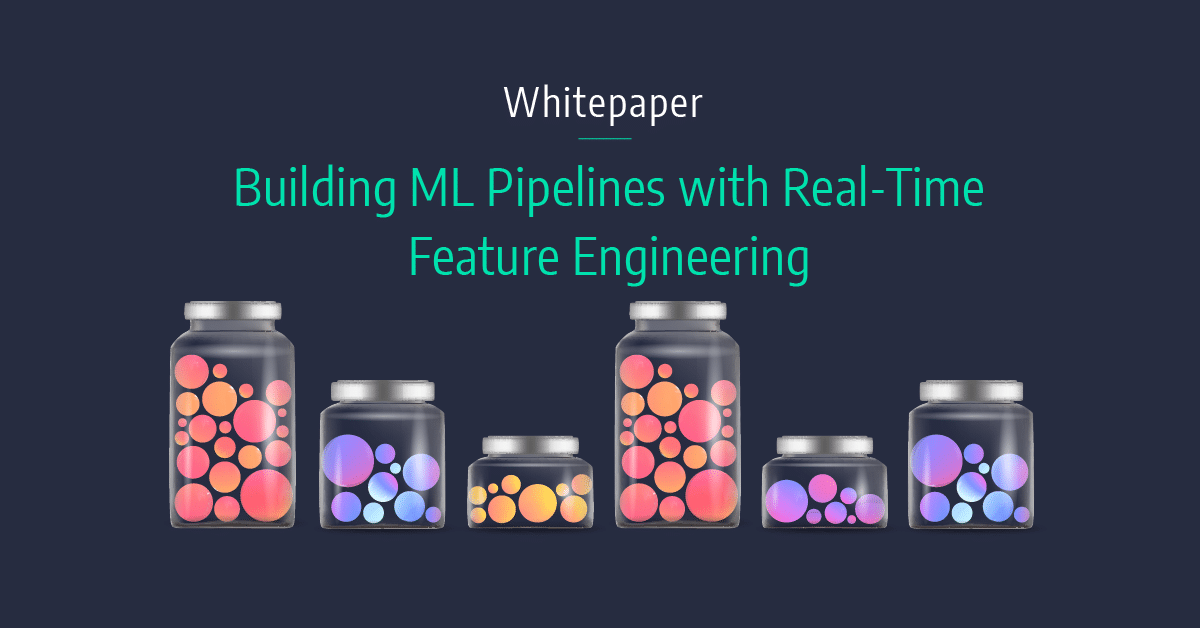Feature engineering selects and transforms the most relevant variables from raw data to create input features to machine learning models for inferencing.
As for deployment, you need to build data pipelines to prepare clean data sets from various sources and generate feature sets. Once up and running, you must then ensure the stability of data pipelines for machine learning models that require essential features. These features affect everything else down the line, so even the best machine learning models will be useless if the quality of your feature extraction is poor.
In this post, we’ll discuss what feature engineering is and how to perform it, plus talk about the benefits of feature store and automation and how Iguazio can help you achieve this.
What Is Feature Engineering?
A feature is an input variable to a predictive model, while feature engineering is the process of generating a set of input features.
The goal of feature engineering is to find the best features that are useful for machine learning models. It is an iterative process where data scientists must find the feature set definition that works well for a machine learning model and is practical to implement in production.
Feature generation involves ingesting raw data, filtering and aggregating it to extract vital data sets, and then transforming it into the desired format, including scaling and normalization.
Feature engineering is crucial, as everything else down the line depends on it. As such, feature generation pipelines must be systematic, stable, and efficient.
How to Perform Feature Engineering
The first step of feature engineering is to design features by obtaining raw data and experimenting with various feature sets. Data scientists may use tools like Jupyter notebooks to perform the following tasks:
- Data preparation/preprocessing: Collecting raw data from multiple sources into a standardized format
- Exploratory data analysis (often called EDA): Identifying the principal characteristics by summarizing, visualizing, manipulating, and statistically analyzing the data
- Feature selection: Choosing relevant features for the predictive model and benchmarking the performance
Data scientists iterate on the process to reduce errors and improve the accuracy of their models. Once the feature set definition is ready for practical use, the second step in feature engineering is to deploy data pipelines and manufacture features in production. The following is a list of points you should pay attention to when doing this:
- Data sets are not static or frozen in the real world.
- We need to collect new data every day, per hour, minute, or even second.
- Often there are multiple data sources for generating the same features.
- Regardless of the above, models expect a unified interface to access features.
It is best to use a good feature engineering framework to automate feature engineering pipelines because manual processing is often prone to error.
Examples of Feature Engineering
There are various methods of feature engineering. In offline feature engineering, data scientists design features and models at the same time. For feature extraction, they may use unsupervised machine learning such as:
- PCA (principal component analysis): Reducing dimensionality and finding which features are most relevant
- Clustering (k-means): Discovering what data are related to each other
- Natural language understanding: Using word embedding vectors to represent elements in natural language sentences (for sentiment analysis, etc.)
Data scientists use offline feature engineering to try out various feature sets with different model architectures. This allows them to see what combination performs best by batch training their models, ultimately yielding a model with a robust feature set.
You can then deploy the designed feature-generation logic into production, where feature engineering runs in real time to process live streams of events. The ingested data goes to two places: an offline feature store that is typically stored as parquet files for training models and an online feature store (fast key-value database) for quick retrieval during inference.
Benefits of Feature Store and Automation
Feature engineering is the key to establishing any AI-empowered business solution. It plays an essential role in the success of enterprise AI projects where data sources are abundant and business logic is more and more complex.
A feature store offers a unified interface to complex features that allows the entire team to work together on offline and real-time feature engineering, meaning there is no need to write separate code for each. Moreover, it can monitor features for drift (i.e., when they become less relevant and effective) and automatically trigger an offline training process using production data.
This automation can eliminate many manual steps in the pipeline and minimize work for your DevOps team—vital for reducing expensive human errors. In short, automation provides stability and efficiency.
The Feature Store as a Data Transformation Service for Training and Serving
To handle the complexities of real-time use cases with streaming data inputs and/or low-latency inferences and actions, ML teams need a very robust and fast data transformation service. The feature store can function as a transformation service designed for feature engineering and more specifically, real-time feature engineering.
To reduce duplicate work and maintain accuracy, there should be one logic that governs the generation of features for both training and serving. A key advantage of a modern feature store is its ability to unify the logic of generating features for both training and serving, ensuring that the features are being calculated in the same way for both layers.
Feature Engineering, Powered by Iguazio
Building robust feature engineering systems in-house is a huge endeavor and a considerable cost for enterprises. Iguazio’s MLOps platform can provide an automated data pipeline and efficient feature store for offline and real-time feature engineering with the following benefits:
- A robust data transformation service
- Full integration of model and feature monitoring out of the box
- A single logic for research and production environments
- Deployments anywhere: any cloud vector, on-premises, and hybrid deployments
Contact experts at Iguazio to learn more, and register for a 14-day free trial today!



